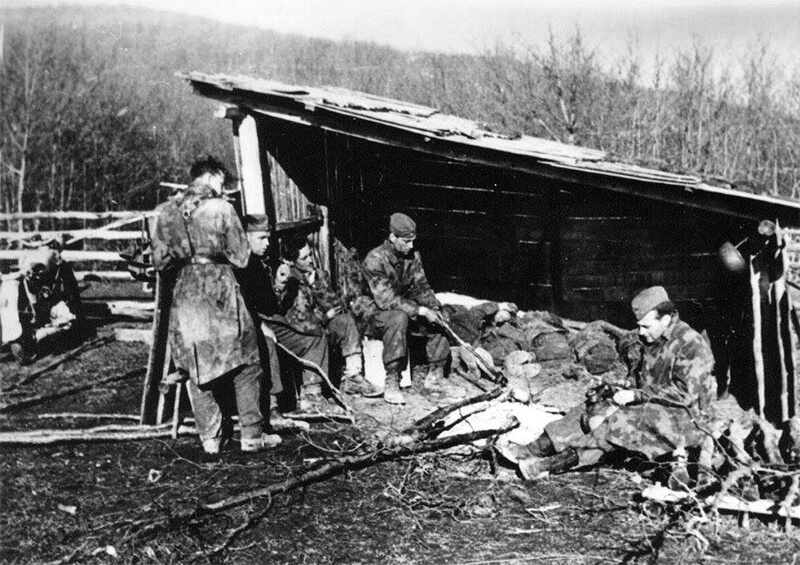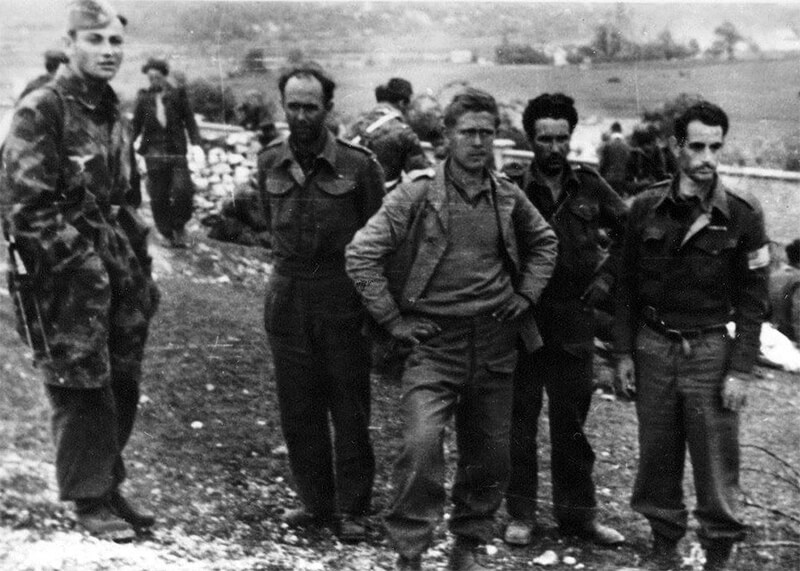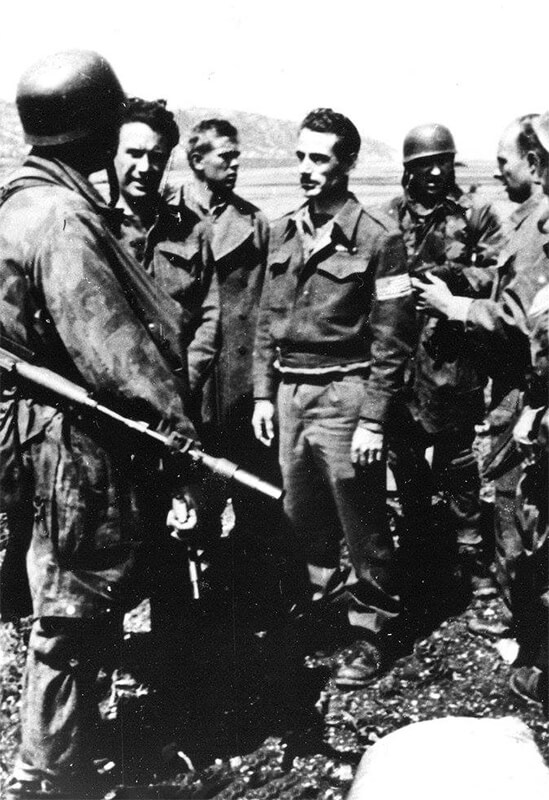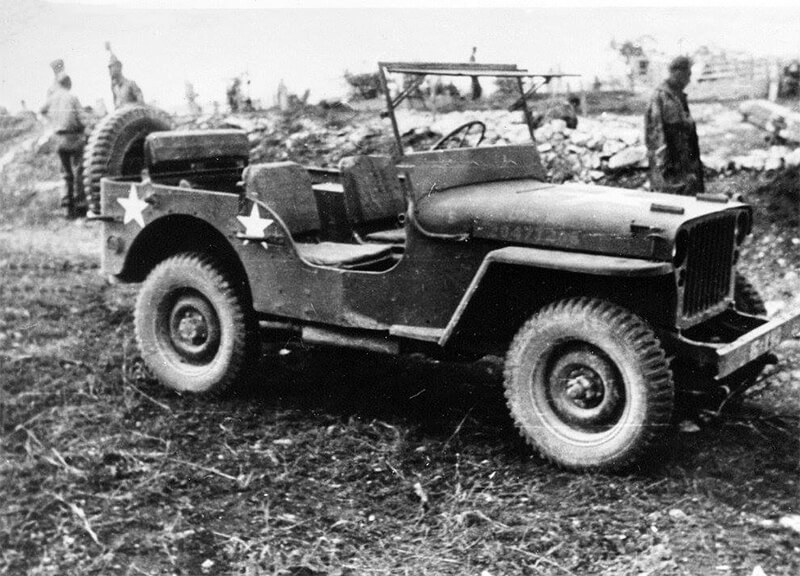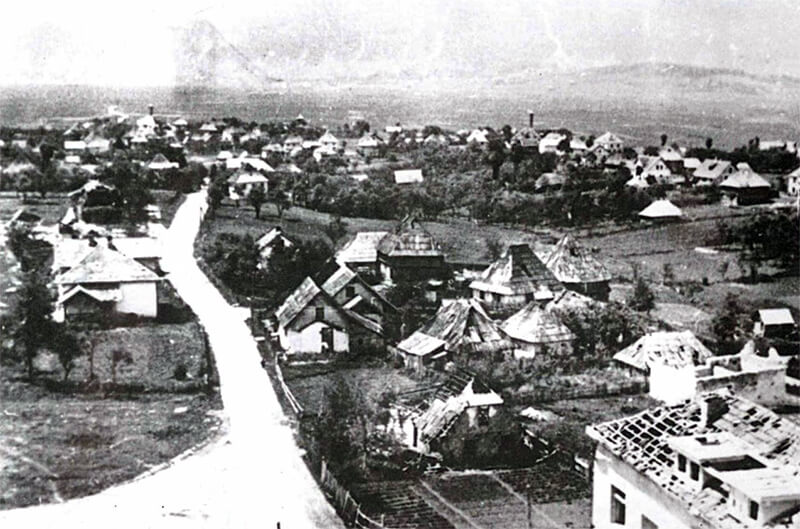| Page Created |
| June 9th, 2023 |
| Last Updated |
| June 24th, 2023 |
| Germany |
 |
| Special Forces |
| Brandenburgers Fallschirmjäger Gebirgstruppen Sonderverband z.b.V. Friedenthal SS-Fallschirmjäger-Bataillon 500 |
| May 25th, 1944 – June 6th, 1944 |
| Unternehmen Rösselsprung |
| Objectives |
- to capture or kill Partisan leader Marshal Josip Broz Tito.
- destroy the Tito’s headquarters and staff.
- destroy Tito’s support facilities.
- Destroy the supporting Allied military missions.
| Operational Area |

Drvar area, Independent State of Croatia
| Unit Force |
- 2. Panzerarmee
- Aufklärungs-Abteilung of the 1. Gebirgs-Division
- Panzer-Abteilung 202
- 4. Regiment Brandenburg
- Grenadier-Regiment 92 (mot.)
- V. SS-Freiwilligen-Gebirgskorps
- 7. SS-Gebirgs-Division
- 181. Infanterie-Division
- 369. Infanterie-Division (kroat.)
- 118. Jäger-Division
- 1. Gebirgs-Division
- XV. Gebirgs-Korps
- 373. Infanterie-Division (kroat.)
- 7. SS-Freiwilligen-Gebirgs-Division Prinz Eugen
- Fliegerführer Kroatien
- II. Gruppe of Transportgeschwader 4
- Luftlandegeschwader 1
- I. Schleppgruppe
- II. Schleppgruppe
- III. Schleppgruppe
- Jagdgeschwader 51 (II./JG51)
- Schlachtgeschwader 2 (I./SG 2)
- SS-Fallschirmjäger-Bataillon 500, reinforced by two companies from the 1. Fallschirmjäger-Regiment of the 1. Fallschirmjäger-Division.
| Opposing Forces |
- 1st Proletarian Corps
- 1st Proletarian Division
- 6th Lika Proletarian Division
- Parts of the 5th Partisan Corps
- 4th Krajina Division
- Part of the 39th Krajina Division
- Partisan detachments: Lebanese-Duvan, Glamochsky and Drvarsko-Petrovatsky;
- Parts of the 8th Corps
- 9th Dalmatian division
- Partisan detachment Grahovsko-Peuljski.
| Operation |
| Prelude |
Following a British-engineered coup against the Axis-friendly government of the Kingdom of Yugoslavia on March 27th, 1941, Adolf Hitler gives the order for the occupation of the country. On April 6th, 1941, German, Italian, and Hungarian troops launch an attack, resulting in the unconditional surrender of the Yugoslav army on April 17th, 1941. The occupation by Axis forces leads to the dismantling of Yugoslavia and the establishment of new state structures in the occupied zones. This includes the NDH state, which heightened ethnic tensions and ultimately escalated into a brutal partisan war.
Initially, the resistance against the occupation is led by the nationalist Serbian Chetniks, with Dragoljub Draža Mihailović as their leader. However, after Germany invades the Soviet Union on June 22nd, 1941, the Communist Party of Yugoslavia, led by Tito, also actively joins the fight against the occupation forces. The political differences between these two main resistance groups creates a complex situation with shifting alliances within a civil war.
Italy’s withdrawal from the war on September 8th, 1943, provides the Yugoslav Partisans with access to significant war material. They not only establish “liberated zones,” particularly in Bosnia, but also gain support from the Western Allies, who had previously backed the Chetniks. Consequently, the Yugoslav Partisans, numbering between 100,000 and 150,000 soldiers, become the primary adversaries of the German occupation forces and are recognised by German leadership as a well-led force with heavy weaponry.
The German commander in Southeast Europe, Maximilian von Weichs, attempts to crush the Yugoslav Partisans through a series of military operations. However, due to limited personnel resources, this proves challenging. The Army Group F, responsible for controlling the occupied areas, has only a few German divisions, with the majority of the occupation troops consisting of the Croatian Legion, NDH state units with German personnel, or divisions recruited from the country that serve in the Waffen-SS.
In 1942, the Waffen-SS begins mobilising ethnic Germans for service, leading to the establishment of the 7. SS-Freiwilligen-Gebirgs-Division, Prinz Eugen This SS division primarily engages in combat against the partisans. Subsequently, two more divisions are formed: 13. Waffen-Gebirgs-Division der SS, Handschar (kroatische Nr. 1) in 1943 and the 23. Waffen-Gebirgs-Division der SS, Kama in 1944, which consisted predominantly of Bosnian Muslims.
| October 1943 – March 1944 |
There are initial discussions regarding the potential deployment of the “Brandenburg” Division against the leadership of the Yugoslav Partisans, specifically targeting Tito himself. The initial group was known as Verband Wildschütz of the Brandenburg Streifkorps under command of SS-Obersturmbannführer Ernst Benesch, operating under Section II of the Abwehr (the Wehrmacht’s intelligence service). Some members of this unit had previously identified Tito’s presence in the town of Jajce before the German offensive to recapture it. Verband Wildschütz, consists of ethnic Germans proficient in local languages. They maintain numerous contacts with both the Chetniks and the Ustaše Militia and are monitoring Tito since October 1943. Leutnant Kirchner, belonging to this unit, plays a key role in locating Tito prior to the recapture of Jajce and establishes a patrol base near Bosansko Grahovo. Although Kirchner comes close to discovering the Drvar cave and identified the presence of Allied military missions, he cannot definitively pinpoint the cave as Tito’s headquarters, despite German radio intercepts confirming Drvar as the site. Kirchner is later assigned to the SS-Fallschirmjäger-Bataillon 500.
Meanwhile a second intelligence organisation is involved in the search for Tito. The FAT Front Aufklärungs Truppe) 216, operating under Section I of the Abwehr. Under the command of Leutnant Zavadil, FAT216 is also attached to the SS-Fallschirmjäger-Bataillon 500 but it makes limited contributions to the intelligence used for planning the raid.
Upon Adolf Hitler’s orders, SS-Jäger-Bataillon 502 under command of SS-Sturmbannführer Otto Skorzeny of the Sicherheitsdienst (SD), the intelligence branch of the SS, also engages in intelligence gathering leading up to the raid. After receiving information from a Partisan deserter that reveals the cave as Tito’s headquarters, Skorzeny proposes a plan to infiltrate Drvar with a small group of soldiers to assassinate Tito. However, when Skorzeny discovers that the plan to eliminate Tito is compromised, he withdraws his unit from the plan.
It appears that he does not pass on the valuable intelligence he had gathered to SS-Hauptsturmführer Kurt Rybka, the commander of the SS-Fallschirmjäger-Bataillon 500, who becomes responsible for planning of the airborne operation. Due to interservice rivalry and competition, the three organisations fail to share the intelligence they have gathered, resulting in significant implications for the tactical planning and execution of the operation.
Meanwhile, Josip Broz Tito, accompanied by General Arso Jovanović, the Chief of the Supreme Staff and a strategist and tactician of the decisive battles of the NOV and POJ, make the decision to transfer headquarters from the town of Drvar to Drvar Cave. Alongside Tito and Arso, the operational part of the Supreme Staff included General Ivo Rukavina, the Chief of the Operational Department, and Colonel Vjekoslav Klišanić, the Chief of the Intelligence Department. Other departments of the Supreme Staff, including the Liaison Department headed by Veljko Dragićević, a trained pilot and radio telegraphist who founded the War Officers School of the Supreme Staff, the Economic Department, Medical Department, Artillery, Technical, Cryptographic, and OZN (Department for People’s Protection), are located within the town of Drvar.
The security of the Supreme Staff, along with the security of the Anglo-American and Soviet military missions, is entrusted to the accompanying battalion of the Supreme Staff led by Milorad Janković, Captain, and Political Commissar Dragutin Božović, Captain, comprising four hundred soldiers and a cavalry squadron. The Engineering Brigade of the Supreme Staff is deployed in Drvar, consisting of two battalions, while two other battalions are stationed in Bosanski Petrovac and Potoci.
In Drvar, the Central Committee of the Communist Party of Yugoslavia (CK KPJ) and the Central Committee of the Communist Youth of Yugoslavia (CK SKOJ) are located, along with the National Liberation Army Council (NKOJ) and several members of the Anti-Fascist Council of the National Liberation of Yugoslavia (AVNOJ). Additionally, the Higher Military Court, together with students attending radiotelegraphic and cryptographic courses, a hospital, a printing house, and the editorial offices of “Nova Jugoslavija” and “Tanjug” are present in the town. The Town Command, Drvar Area Command, and the war theater group Narodno oslobođenje, along with the Officer School of the Supreme Staff, are also based in Drvar.
| March 1944 |
The German leadership successfully uses radio direction finding to locate the new position of the Supreme Staff in Drvar. This discovery presents a valuable opportunity to deal a severe blow to the Yugoslav Partisans and dismantle their leadership structure.
| May 6th, 1944 |
The Armeeoberkommando der 2. Panzerarmee under command of Generaloberst Lothar Rendulic, receives instructions from the Oberbefehlshaber Südost (OB Südost) to prepare for the encirclement and destruction of the Yugoslav Partisan forces concentrated around Drvar. Alongside the XV. Gebirgs-Korps, commanded by General der Infanterie Ernst von Leyser,the V. SS-Gebirgs-Korps is assigned the 2. Panzerarmee. As well as Panzer-Abteilung 202, 4. Regiment Brandenburg and the Grenadier-Regiment 92 (mot.) from the reserve forces of OB Südost.
| May 7th, 1944 |
The Aufklärungs-Abteilung of the 1. Gebirgs-Division of the reserve of the OKW and, following a separate request from the Wehrmacht High Command, the SS-Fallschirmjäger-Bataillon 500 under the Reichsführer SS are added. The participating air forces are under the command of the Fliegerführer Kroatien.
| May 13th,1944 |
The guiding principles for the operation are communicated to OB Südost, outlining the plan to parachutedrop the SS-Fallschirmjäger-Bataillon over Drvar. They are to join forces with units from the “Brandenburg” Division, operating in full camouflage. Their objective is eliminating the enemy command center. Simultaneously, an offensive is launched against Drvar using five motorised combat groups, each with the strength of a regiment, to provide relief for the troops.
| May 19th, 1944 |
In the days preceding the start of the operation, the Luftwaffe conducts intensified aerial reconnaissance over the operational area in Drvar, which does not go unnoticed.
Despite the Germans’ preparations being noticed by the Allies, the specific objective of the operation remained unknown. Just days before the attack on Drvar, the military missions of both Britain and the United States relocate their headquarters from Drvar due to heightened German aerial reconnaissance.
The operational preparations for the upcoming mission are undertaken by the XV. Gebirgs-Korps, led by General Ernst von Leizer, with its headquarters located in Knin. The corps headquarters presents a detailed operational plan, which is subsequently approved with minor modifications. The plan involves a force of approximately 20,000 personnel. In summary, the plan can be outlined as follows:
In western Bosnia, the communist leadership establishes the General Headquarters of Tito and the Allied military missions. The area of Bosanski Petrovac contains an airfield and warehouses, housing approximately 12,000 individuals armed with heavy weaponry, including artillery, anti-tank weapons, and several tanks. The roads are obstructed by ditches, minefields, and prepared ambush positions. Expect strong resistance from the 1st Proletarian Division southeast of Mrkonjic-Grad and the 6th Proletarian Division in the upper reaches of the Unac River.
In the early morning hours of the attack day (X-day), dive bombers execute precision strikes on enemy positions, command posts, and anti-aircraft weapons. Subsequently, the SS-Fallschirmjäger-Bataillon 500, reinforced by two companies from the 1. Fallschirmjäger-Regiment of the 1. Fallschirmjäger-Division is deployed by parachutes and gliders and lands in Drvar.
The aircraft and airborne troops are assigned with the task of neutralising enemy command posts and key positions in Drvar. The success of this operation will have a decisive impact on the outcome of the conflict along the Adriatic coast and in the rear. Meticulous planning, effective command, and the full engagement of all participating soldiers will be of utmost importance.
The regimental group of the 7. SS-Freiwilligen-Gebirgs-Division Prinz Eugen supported by the Grenadier-Regiment 92 (mot.) of the 2. Panzerarmee, is tasked with breaking through the enemy’s defences east of the Sana River and advancing northward between the Sana and Unac rivers. The Grenadier-Regiment 92 (mot.), accompanied by a Panzer Kompanie from the Panzer-Abteilung 202, will initiate their advance from Banja Luka and capture the town of Key. The second regimental camp group of the 7. SS-Freiwilligen-Gebirgs-Division Prinz Eugen will advance along the railway line from Jajce and secure control over Mlinista, which houses important infrastructure such as a power station. The 105. SS-Aufklärungs-Abteilung, reinforced by a tank company equipped with ten Italian M15/42 tanks, is assigned the task of defeating the enemy forces on the Livanjsko Pole, seizing the partisan warehouses located there, and launching an offensive through Bosansko Grahovo toward Drvar, thus preventing the retreat of the partisan groups, headquarters, and allied missions to the south. The 369. Aufklärungs-Abteilung of the 369. Infanterie-Division (kroat.), under the command of the 105. SS-Aufklärungs-Abteilung, will advance through Livno to Glamocko Polje in order to cut off the enemy’s southeastern escape route. The defense of Livno is crucial in any case.
On the designated day, the 373. Infanterie-Division (kroat.), in conjunction with the William battle group, will launch an offensive from the Srb area toward Drvar, and their primary objective is to link up with the SS-Fallschirmjäger-Bataillon 500 at all costs. The complete destruction of all partisan and allied mission command structures is imperative. Following the occupation of Drvar, the offensive will continue in the direction of Bosanski Petrovac. The battle group Lapac will advance through Kulen Vakuf to Vrtoce, seizing control of the Bihac-Vrtoce road.
On the of the assault, the Grenadier-Regiment 92 (mot.), along with the 54. Gebirgs-Aufklärungs-Abteilung of the 1. Gebirgs-Division and the 2. Jäger-Battalion of the 118. Jäger-Division of Bihac under its command, will launch an attack on Bosanski Petrovac from the southeast. Their primary objective is to swiftly capture the warehouses and the airfield. The success of this group’s actions is crucial. Additionally, a portion of their forces will advance toward Drvar to join forces with the SS-Fallschirmjäger-Bataillon 500 and the William battle group, aiming to cut off the enemy’s retreat to the north.
The 4. Regiment Brandenburg, accompanied by the Chetniks under its command, advances from Knin towards Bosansko Grahovo with the objective of conducting sabotage operations on the Drvar-Prekaja line.
At the same time logistical aspects of supply, communication, and other relevant factors are being coordinated and addressed. They have to be managed to support the ongoing operations. At the attack day (X-day), the headquarters of the XV. Gebirgs-Korps is situated in Bihac.
The Luftwaffe provides 40 Junker 52 transport aircraft from the II. Gruppe of Transportgeschwader 4, as well as 34 gliders from Schleppgruppe 1 and the II. and III. of Luftlandegeschwader 1 for the transportation of the Fallschirmjäger. The DFS 230 B-1 gliders are towed by 17 Henschel Hs126, 12 Junker JU87, and five Avia B.534 aircraft. For ground support, one group from Jagdgeschwader 51 (II./JG51) and one group from Schlachtgeschwader 2 (I./SG 2) are available. Due to a shortage of transport aircraft and gliders to transport the reinforced battalion simultaneously, three groups are formed. The first group (314 men) will use parachute to enter the operational area, while the second group (340 men) will land in gliders. The remaining 220 men are scheduled to land in a second wave using parachutes.
The glider group is divided into six Kampfgruppen. The strongest group, Kampfgruppe Panther (110 men), is tasked with capturing the Zitadelle objective, where Tito and his staff are believed to be located. This objective consists of a fortified cave in the surrounding hills of the city. Kampfgruppen Greifer (40 men), Stürmer (50 men), Brecher (50 men), and Beißer (20 men) are assigned to capture the allied military missions, while the combat group Draufgänger (70 men) is assigned to the radio station.
The parachute group form three Kampfgruppen, Blau (100 men), Grün (95 men), and Rot (85 men), with the task of seizing the city and preventing breakout attempts. The battalion staff of thirty-four men accompanies them. The second wave (220 men) is to be brought in as soon as possible. On the eve of X-Day, the combat groups of the two Gebirgskorps discreetly assume their positions near Knin, Srb, and Bihać.
| May 21st, 1944 |
Hitler approves the plan, designating May 25th, 1944, as X-Day, the official start of the operation. The Germans had discovered forged documents indicating that Tito’s birthday was on May 25th, leading them to schedule the attack for that specific day.
The SS-Fallschirmjäger-Bataillon, reinforced by two companies from the 1. Fallschirmjäger-Regiment of the 1. Fallschirmjäger-Division, is placed in strict isolation and readiness in Kraljevo. All distinctive markings are removed, and the soldiers wear regular infantry uniforms. To aid identification, each of the 875 men is given a photograph of Tito.
| May 24th, 1944 |
Tito organises a reception for members of the Anglo-American and Russian military missions, suggesting that they stay overnight in the same building in the town. He spends the night with the mentioned officers in Drvar Cave, in an improvised barrack at its entrance. The evening before the airborne operation in the town, newsreels are shown to the members of the partisan units, featuring “The Battle of Stalingrad” and “The Crimean Offensive.”
| May 25th, 1944 |
Precisely at 6:30, the operation starts with a surprise bombing attack carried out by the Heinkel He-46 and Henschel Hs-126 light attack aircraft of the Stab. 1, 2 / NSGr.7). The aircraft skillfully evade detection as they approach their targets at a low altitude. In the second wave, the city center is attacked by Junkers Ju-87D II bombers from the II./SG151 unleashing powerful 125- and 250-kilograms bombs.
At 6:50, the third wave of attacks starts, conducted by the dive bombers of the 13./SG.151, persisting until 6:55. This is followed by the fourth and final assault by the 3./NSGr.7, employing Italian CR-42 aircraft, which continues until 7:00. The dive bombers and attack aircraft are provided cover by the Messerschmitt Bf-109G IV fighter aircraft of the IV./27JG.
At exactly 7:00, the first Junkers-52 transport aircraft appeared above Drvar, dropping 314 Fallschirmjäger belonging to the SS-Fallschirmjäger-Bataillon 500.
By 7:10, the initial batch of forty-five DFS-230 airborne gliders touches down. This wave delivers a total of 340 Fallschirmjäger.
A number of gliders experienced significant deviations from their intended landing zones. One glider lands in front of the Bastasi cave, situated approximately seven kilometres west of Drvar. Additionally, several gliders land in a locality called Vrtoče near Drvar.
The occupants of the glider that lands in Bastasi are immediately confronted and killed by members of the Tito Escort Battalion, who are responsible for guarding the cave. As for the occupants of the gliders in Vrtoče, they engage in combat and fight their way towards Drvar in order to proceed with their mission.
The first wave aimed to land 654 Fallschirmjäger. Some partisans manage to infiltrate a few gliders, resulting in one being forced to detach from its tow and land outside Drvar, while two others were shot down and three suffered damage. The combined losses among the crews and the paratroopers amounted to twenty individuals.
During the landing, Junkers Ju-87 dive bombers engage in suppressing ground targets in the Drvar area by utilising machine-gun fire, effectively driving the defenders into cover. The coordination of these aerial operations is facilitated from a mobile command center situated on either a Junker Ju-88 or a Heinkel He-111 aircraft.
Simultaneously with the airborne assault, the German ground offensive is initiated, involving approximately 20,000 men with the objective of dismantling the Tito state in Drvar. Fierce battles erupt across all nine areas where German forces advance. The group known as William launches an attack from Srba, with the intention of reaching Drvar by the evening of May 25th, 1944, and relieving with the Fallschirmjäger of the SS-Fallschirmjäger-Bataillon 500.
Following their successful landing, the paratroopers regroup and proceed to advance towards their assigned targets, forming chains in the process.
Gruppe Panther, supported by Gruppe Rot, encounters minimal resistance as they advance towards the cemetery. Rybka, the commander, establishes his headquarters behind the protective walls of the cemetery, but they find no trace of Tito or his headquarters. Gruppe Greifer, Stürmer, Brecher, and Beißer face similar disappointment, as the Allied military missions have already relocated based on aerial reconnaissance conducted on May 23rd, 1944.
Parts of Gruppe Stürmer experience a different challenge, as their gliders land in a field just south of the Drvar cave. They came under fire from members of the Tito Escort Battalion positioned on the high ground in the vicinity of the cave.
Meanwhile, Gruppe Draufgänge successfully lands their gliders at the Western Cross location and launches an assault on a building they believe to be the Partisan communications center. However, the targeted building turns out to be the office of the Communist Party of Yugoslavia Central Committee. The occupants of the building fiercely defend it until it is eventually destroyed using satchel charges.
Gruppen Blau and Grün comprised of Fallschirmjäger troops landed by parachute, engages in an intense combat as they land in the eastern part of Drvar. In this part of the town the majority of the population resided. It should be noted that Drvar had recently hosted a conference organised by the Young Communist League of Yugoslavia, and many delegates from the conference are still present in the town. Consequently, numerous young individuals arm themselves with whatever weapons they can find and fiercely fight against the Fallschirmjäger who are attempting to establish a cordon on the eastern side of the town.
Upon the German occupation of Drvar, it becomes clear that the main positions of the partisans are situated on the opposite side of the Unac River, where Tito himself is believed to be located. The Germans had received information regarding the presence of Tito’s headquarters in a cave on the slope of Mount Gradina, but the exact location remained undisclosed.
However, the successful parachute jump and landing of the Germans, led by Battalion Commander Rybka, leads to the fact that the individual combat groups proceed according to their instructions. Kampfgruppe Greifer, advances against the Zitadelle and becomes engaged in fierce defensive battles with the enemy. Between 09:00 and 10:00, a succession of Fallschirmjäger launch an offensive along Drvar’s main street towards the Unac river, targeting the positions held by a security battalion and reinforced by officers from Shipovlyan. The partisan positions come under fire from a Fallschirmjäger battery of Krupp’s LG 40 75 mm gun and two batteries of 50mm mortars. However, the paratroopers’ attack encounters strong resistance roughly 105 steps away from Unac. Subsequent assaults are also repelled by the fierce defensive fire, compelling the Germans to retreat and seek refuge in houses on the outskirts of Drvar. A temporary lull ensued in the battle.
During that same period, Tito’s Supreme Headquarters, organises the defence of the cave and informs the officer cadets, who are conducting exercises about 1 1/2 kilometers away from Drvar, through messengers. While the Germans increasingly focus their attacks on the cave – with a large part of the town already under their control – more than one hundred officer cadets join the fighting from the southwest around 08:00, preventing a German flank attack on the headquarters. Meanwhile, urgent orders are sent by telephone from headquarters to the 5th Corps and the 1st Division, instructing them to stop the advancing German troops from Jajce and Bihac towards Drvar at all costs.
The Supreme Staff wants Marshal Tito to immediately evacuate the cave and relocate to a safer location. Tito was accompanied only by his adjutant and a few close associates, while the Supreme Staff and its chief were located somewhere near the cave. Due to broken radio communication, messengers are the only means of communication with headquarters.
Repeatedly, the headquarters sends messages to Tito urging him to leave the cave. Official documents mention offers made at 09:30, 09:45, and 10:00 hours. However, Tito makes the decision to leave the cave only after 10:00, when it becomes evident that remaining there is dangerous. It is surprising that the Supreme Commander was not with his headquarters for a full four hours after the German offensive began and communicated solely through notes.
During this time, the Supreme Headquarters dispatches messengers to nearby units and formations, issuing orders to clarify the situation in Drvar and provide information about the status of the Supreme Commander. These orders are issued directly by the Supreme Headquarters and not on behalf of Tito, suggesting independent action taken by the Supreme Headquarters.
Hauptsturmführer Kurt Rybka, the commander of the SS-Fallschirmjäger-Bataillon 500, still has the option to order the second wave of 171 Fallschirmjäger to land directly on the mountainside above the Tito Cave, with it blocking the retreat route. The reasons behind Rybka’s decisions remains unknown. He might have become aware that the German offensive in Drvar was not progressing as swiftly as anticipated, and partisan reinforcements were en route. It is plausible that communication with higher headquarters had been temporarily disrupted, preventing him from making alterations to the prearranged plan. Once radio communication is restored, the Fallschirmjäger themselves are compelled to defend against counterattacks launched by the partisans, necessitating the concentration of all available forces in Drvar rather than deploying them on the opposite side of the river. Furthermore, Rybka might have harbored lingering uncertainty regarding Tito’s presence in the cave. Otherwise, he would likely have taken more decisive action. Regardless, Rybka opted to adopt a defensive posture.
Only Tito, Arso Jovanović, Aleksandar Ranković, Veljko Dragićević, and General Sreten Žujović remain in the cave. In the battle with the Fallschirmjäger, Chief of the Liaison Department of the Supreme Staff, Veljko Dragićević, is killed, and the entire radio-telegraphy base with signals is destroyed. As a result, Generals Ranković and Jovanović issue orders for all communication with the operational headquarters of the NOV and POJ to be conducted through couriers, who heroically carry out this crucial task.
By 10:00, the German forces gain complete control over Drvar. The majority of partisan radio stations are either destroyed or captured, and the Germans also obtain numerous cipher documents. This severs the communication lines of the partisans, resulting in disrupted coordination. While some partisans are killed on the spot and others are taken as prisoners, a significant number manages to evade capture. Reports indicate that the partisans suffer a loss of approximately one hundred soldiers in Drvar. Additionally, several members of foreign military missions either lost their lives or were captured. The Fallschirmjäger themselves suffer sixty casualties during this phase of the operation.
The Germans enlisted some local residents to assist in tasks such as digging trenches and gathering ammunition. The Shobich-Glavitsa cemetery, enclosed by a stone wall on two sides, becomes the primary defensive position for the Fallschirmjäger, housing their command post. The cemetery is fortified and prepared for all-around defense. It serves as an ammunition storage area, has a medical station, and serves as a gathering point for fallen soldiers. Other defensive positions are also prepared throughout Drvar. The battalion headquarters recognises that the the William group is encountering strong resistance from the partisans, causing delays in being relieved. The reconnaissance squadron “Croatia” reports the arrival of additional partisan forces from Srba. In response, the Rybka orders the remaining 171 soldiers to land on the field in front of Shobich-Glavits. The second wave, led by SS-Hauptsturmführer Obermeier, lands by parachute three and a half hours after the first wave. Ten Ju-52 aircraft drop parachute containers containing ammunition and medical supplies at the designated location. They are promptly thrown into battle at Kamenice.
Fortunately, the first units of partisans arrive from the surrounding areas of Drvar, members of the 3rd Lika Brigade. They successfully attempt to drive the attackers away from the cave. At approximately 11:15, Tito, leaves the cave that serves as their headquarters. The soldiers of the security battalion and Tito’s personal guard devise a resourceful plan to escape the imminent danger. They create an opening in the floor of a hut, enabling them to descend using ropes from parachute lines. Although some volunteers lose their lives during the descent, Tito manages to navigate through a narrow crevice in the rock, providing him cover from enemy gunfire. Safely maneuvering across the exposed area, he seeks refuge behind a large rock. From this vantage point, Tito directs the security battalion to hold their position, while he and his closest associates commence the ascent of Mount Gradina.
By approximately 12:00, Tito reaches the summit and Tito, Kardelj, and the remaining members of the Supreme Headquarters manage to join a partisan group led by Rankovic, which is fighting above the cave. From h ere he observes the ongoing battle before proceeding towards Podovi, situated fifteen kilometres away, where they are joined by the surviving Allied military missions. The group conceals themselves in this area.
By this time, battalion Commander Rybka is wounded in the fighting. He is evacuated in the Fieseler Storch aircraft, which was originally intended for Tito. Subsequently, Captain Bentrup from the 1. Fallschirmjäger Regiment assumes command. He orders his men to withdraw to Drvar where they eventually entrench themselves on the nearby cemetery hill.
During the fights around the cave, intense clashes with partisan units present in the city are going on. With the support of combat aircraft, the Fallschirmjäger manage to seize control of Drvar by around noon. Regrettably, there is no regard for the safety of the civilian population during the urban combat.
The headquarters of the 1st Proletarian Corps, situated in the village of Mokronoge near Drvar, swiftly receives information about the German landing and promptly issues orders for assistance. The 6th Proletarian Division dispatches one brigade, the 3rd Likes Brigade, consisting of four battalions, to Drvar. Additionally, the 1st Dalmatian Brigade, under the command of the 9th division, sends its closest battalion to Drvar. Two battalions from the 1st Proletarian Likes Brigade, deployed by the headquarters of the 1st Likes Corps, are also sent to Drvar. Approximately 1,000 partisans undertake a forced march to reach Drvar.
At 11:30, the 1st battalion of the 3rd Likes Brigade (130 soldiers) reached the heights near the village of Kamenice and launch an immediate assault on German positions at the Stavkowice railway station. In the ensuing skirmish, the Germans suffer seven fatalities, a dozen wounded, and are compelled to retreat to the nearby cemetery.
This is around the time that the second wave lands. Despite mutual attacks and counterattacks on the rocky terrain near Kamenice, neither side achieves a definitive victory. However, the Germans are forced into a defensive position. The partisans of the 3rd Likes Brigade are joined by groups and individual soldiers from an Engineering Brigade, as well as various units and institutions of the NOAU (National Liberation Army of Yugoslavia) who manage to break out of Drvar. The Partisan positions are repeatedly subjected to air strikes.
Around 13:00, the 3rd battalion of the 6th Likes Division, led by the division commander, arrives in Drvar. The battalion immediately launches an attack against the left flank of the German positions in the Drvar Valley. The 1st company crosses the Zoritsa bridge to reinforce the defense of the guard battalion, the 2nd company advances along Bastasi Street, and the 3rd company moves through Spasovin.
The German commander is forced to strengthen the defence in this direction. The first battles commence around 14:00. The 2nd company of the 3rd Likes battalion manages to suppress German machine-gun nests through mortar fire, and by 16:40, they have driven the Germans to the central intersection of Bastasi Street, where the city government is located. Intense fighting ensues, with the council building changing hands several times. Eventually, the Germans retreat to Schobić-Glavitsa cemetery. The security battalion successfully pushes the Germans out of the right bank of Unac by 16:45 and crosses to the opposite side. Around the same time, the 1st Battalion of the 1st Proletarian Brigade, which is held in reserve, arrives. Subsequently, the 2nd battalion of the 3rd Likes Brigade attacks the Germans’ left flank in motion. The 3rd company of the 2nd battalion engages in fierce combat, forcing Gruppe Brecher to retreat from Trninich-Brek to Kninska Kapya. The Germans briefly take cover on the railway tracks but retreat to Trnjak after the arrival of the 1st company and units from the Engineering Brigade at around 18:00.
The 4th battalion of the 3rd Likes Brigade (130 soldiers) reached Drvar at approximately 17:00 and is held in reserve in case of a new German landing.
By 20:00, most of the Fallschirmjäger are pushed back to the area around the Schobić-Glavitsa cemetery. The barriers the Fallschirmjäger established on the main street of Drvar and in the direction of Prnjavor are also forced to withdraw by 21:30. However, five transport aircraft successfully deliver containers of ammunition to the remaining German-held positions.
By now the focal point of the German defence is the cemetery situated on the hill of Schobić-Glavitsa. Concrete walls protect it from Kechmani and the pulp mill, with sappers creating loopholes in these barriers. Local residents were forced to dug trenches of full profiles with parapets on the field where the second wave of the landing had occurred. Stone crosses also served as cover for individual marksmen. The Germans now find themselves surrounded from all directions by four battalions of the 3rd Likes Brigade and the 3rd Dalmatian Battalion, which had arrived later.
At 23:00, the partisans launch an attack from all directions, supported by mortar fire. The Germans respond by firing numerous illumination flares, flooding the area with light and depriving the partisans of the cover of darkness. Armed with an ample supply of automatic weapons and sufficient ammunition, the Germans unleash a lethal barrage, swiftly repelling the assault.
| May 26th, 1944 |
Throughout the night, the Fallschirmjäger’ positions at the cemetery in Drvar come under repeated attacks from the four battalions of the 3rd Brigade, and the 9th Dalmatian Division.
A subsequent attack commences at 01:00 led by the 3rd and 4th battalions of the 3rd Likes Brigade, supported by mortars and utilising hand grenades. However, this assault also fails to achieve success, with instances of German counterattacks occurring in certain areas. In the third attack, at approximately 02:00, the 1st battalion of the 1st Proletarian Likes Brigade joins the fray but yields the same outcome. Another assault at 03:30 is likewise repelled by the Germans at great cost.
The attacks inflict heavy losses on the Germans. At the peak of the fighting, a partisan group manages to breach the German defensive ring, but they are swiftly eliminated in a counterattack by the Fallschirmjäger. As the day breaks, the partisans are compelled to retreat due to the renewed threat of German air strikes. At 07:00, twelve Ju-52 aircraft air-dropped urgently needed supplies, particularly ammunition.
During the night, the command of the National Liberation Army of Yugoslavia (NOAU) receives information about the potential breakthrough of the 92. Grenadier (mot) Regiment towards Bosansky Petrovac. In response, orders are issued to the NOAU forces to withdraw from Drvar. The plan is to complete the evacuation before dawn, in order to avoid the threat of air strikes.
At approximately 6:00, in Kamenitsa, located in the rear of the 1st battalion of the 3rd Likes Brigade, the advance guard of the advancing Gruppe William appears. This vanguard consisted of the 1. kompanie of the 373. (kroat.) Infanterie-Division. After a brief skirmish, the 1st and 3rd battalions of the Likes Brigade decide to retreat.
At approximately 10:00, the leading elements of the Aufklärungsabteilung 373 arrive in Drvar, relieving the surviving Fallschirmjäger. By noon, the remaining forces of the kampfgruppe, the 373. (kroat.) Infanterie-Division, the 92. Grenadier-Regiment (mot.) and the Kampfgruppe Willam den Ort, also reach the area. They force the partisan forces out of Drvar.
| May 27th, 1944 |
After relieving the Fallschirmjäger, the XV. Gebirgs-Korps issues instructions for the units stationed in the Drvar region to disperse. The Grenadier-Regiment 92 (mot.), along with its subordinate units, received orders to return north and launch an attack on the brigades of the 4th Krajina Division situated on Mount Grmeč. The objective was to secure the main supply road from Bihać to Bosanski Petrovac. This operation, codenamed “Grmeč,” is planned to commence on the morning. Simultaneously, the 373. Infanterie-Division (kroat.), together with the newly placed 1. Regiment, Brandenburg Division, is tasked with conducting a sweep-and-destroy mission in the southern and southeastern areas of Drvar. This operation, codenamed “Vijenac,” is scheduled to take place alongside “Operation Grmeč.”
Despite their efforts, the 9th Dalmatian Division successfully repells all attacks, driving back the Brandenburgers and Chetnik forces to Bosansko Grahovo. On the same day, the Aufklärungsabteilungabteilung 369 makes another unsuccessful attempt to advance towards Glamoč. These developments leave Rendulic dissatisfied with the progress of the operation. Consequently, he decides to cancel Operations “Grmeč” and “Vijenac” in the afternoon.
Instead, he orders von Leyser to maneuver all units back to their original positions for a coordinated assault on the area suspected to house Tito and the headquarters of two Partisan corps (1st Proletarian Corps and 5th Proletarian Corps). The attack is planned to commence on the morning of May 28th, 1944. Additionally, Rendulic dispatches the SS-Aufklärungsabteilungabteilung 105 to the Livno-Glamoč region, which has been left vulnerable due to the failure of the Aufklärungsabteilungabteilung 369 advance.
| May 31st, 1944 |
Lieutenant General Nikolai Vasilevich Korneev, the leader of the Soviet mission, proposes an air evacuation to rescue Tito and the Soviet mission. This proposal is expanded by Street, and it is decided to include the entire party.
| June 3rd, 1944 |
After three days of discussion, Tito agrees to the plan. Street makes arrangements for the evacuation, which takes place that same night from an airfield near the town of Kupres. The airfield is operated by the Royal Air Force. The evacuation involves seven Douglas C-47 Skytrains, one with a Soviet crew and the rest with U.S. crews. They transport Tito, his staff, the Allied military missions, and 118 wounded Partisans to Bari in Italy.
| June 6th, 1944 |
The clashes with units from the Yugoslav People’s Liberation Army in western Bosnia persist until June 6th, 1944, when the German high command officially concludes the operation.
On the late evening, the Royal Navy escort destroyer H.M.S. Blackmore delivers Tito to Vis Island, where he re-establishes his headquarters and is later joined by the Allied military missions.
| Conclusion |
In the battles fought in the Sanski Most and Glamoč area, the XV. Gebirgs-Korps suffered a total of 1,145 casualties, including 213 fatalities, 881 wounded, and fifty-one missing. They reported inflicting 1,916 “confirmed” casualties on the enemy and capturing 419 men. The SS-Fallschirmjäger-Bataillon 500 lost 576 killed and forty-eight wounded out of the 874 soldiers deployed, resulting in a casualty rate of 71 percent. According to reports from the High Command of the German Armed Forces (OKW), the partisan forces suffered 6,240 casualties, including prisoners.
| Multimedia |
| Unternehmen Rösselsprung |

























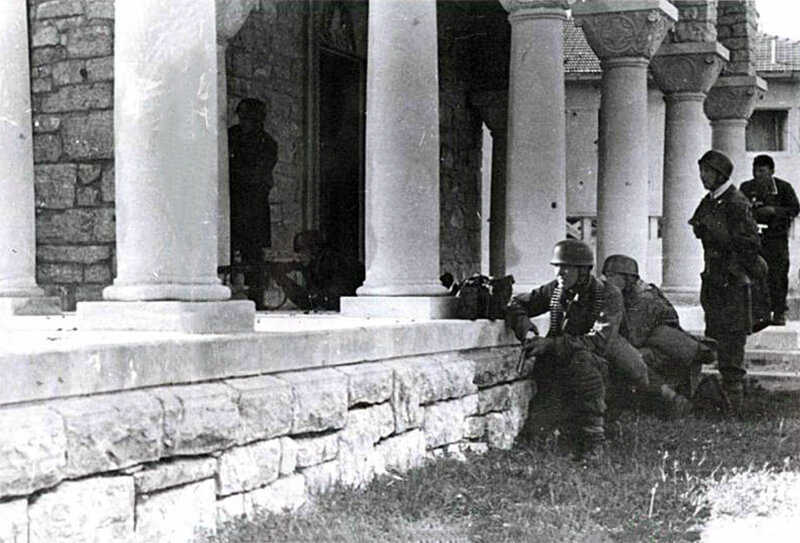



















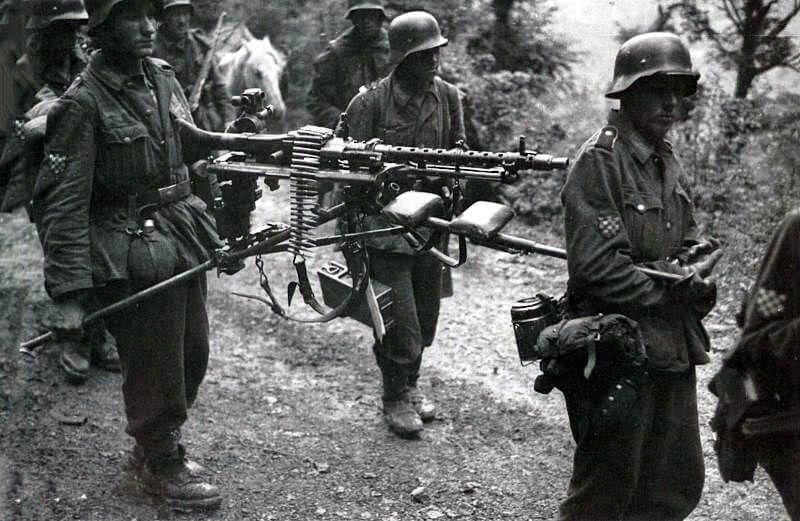
| Aftermath |
